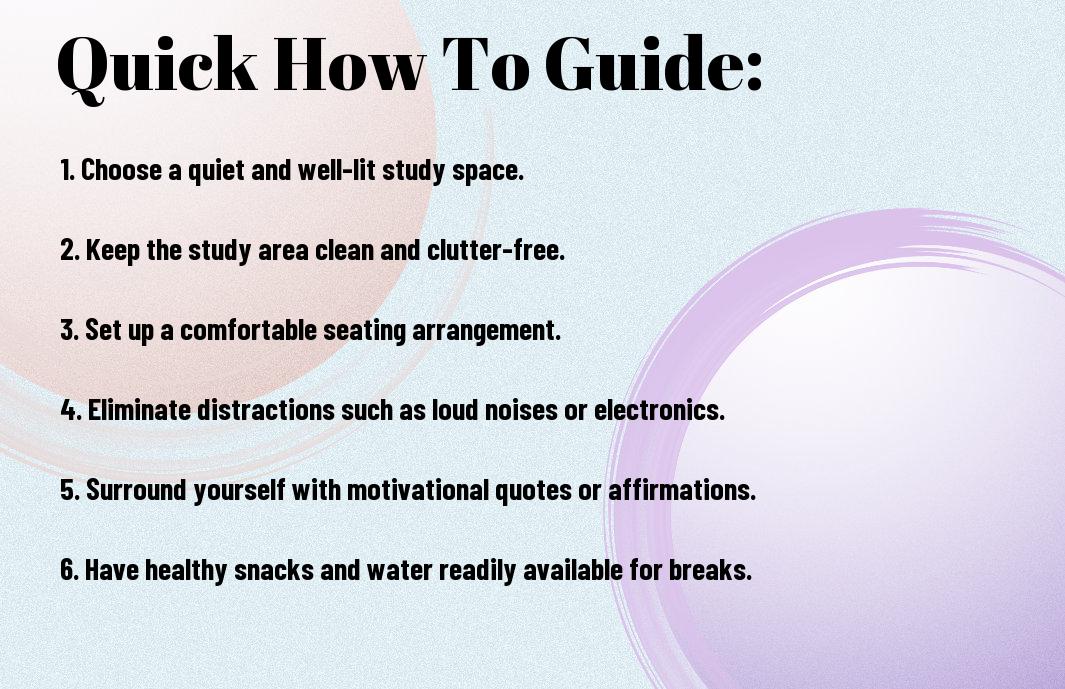How to Create a Supportive Study Environment to Combat Lack of Motivation in Middle School

Do you find yourself grappling with a lack of motivation when it comes to studying in middle school? It’s a common challenge for many students, but creating a supportive study environment can make a world of difference. By implementing some key strategies and making a few changes to your study space, you can combat those feelings of lack of motivation and set yourself up for academic success.
First and foremost, it’s important to eliminate distractions in your study space. This means finding a quiet, clutter-free area where you can focus without interruptions. Additionally, surrounding yourself with motivational quotes, posters or images that inspire you can help keep you in the right mindset. It’s also crucial to establish a consistent study routine and set realistic goals for yourself. With the right environment and mindset, you’ll be well on your way to overcoming lack of motivation and excelling in your studies.
Key Takeaways:
- Establish a dedicated study space: Providing a specific, comfortable space for middle schoolers to study can help them stay focused and motivated.
- Limit distractions: Minimizing noise and technology can help create an environment conducive to studying and combat lack of motivation.
- Encourage organization: Teaching middle schoolers how to stay organized with their materials and assignments can help reduce stress and increase motivation.
- Offer positive reinforcement: Praising effort and progress can help boost motivation and create a supportive study environment.
- Provide resources and support: Offering access to educational resources and being available to provide support and guidance can help motivate middle schoolers to succeed academically.

Assessing the Current Study Environment
Clearly, one of the first steps in creating a supportive study environment for middle school students is to assess the current state of their study space. This involves taking a close look at the physical setting and evaluating the potential distractions and barriers that may be hindering their motivation and focus.
Identifying Distractions and Barriers
When assessing the study environment, it’s important to identify any potential distractions and barriers that may be impeding your ability to concentrate and stay motivated. This could include a cluttered or disorganized workspace, noisy surroundings, or even digital distractions such as social media and electronic devices. Identifying and addressing these distractions is crucial to creating an environment that fosters motivation and productivity.
Surveying Student Needs and Preferences
Another important aspect of assessing the study environment is surveying your own needs and preferences. Take some time to think about what kind of environment helps you feel most focused and motivated. Consider factors such as lighting, noise level, and the layout of your workspace. Additionally, think about any specific tools or resources that you find helpful, such as highlighters, sticky notes, or a comfortable chair. Understanding your own needs and preferences will help you tailor your study environment to best support your learning and motivation.
Fundamental Elements of a Supportive Study Space
Not having a supportive study environment can make it difficult for you to stay motivated and focused on your studies. Creating a supportive study space is essential for combating lack of motivation and ensuring that you can perform to the best of your abilities.
Ergonomics and Comfort
When it comes to creating a supportive study environment, ergonomics and comfort play a crucial role. It’s important to ensure that your study space is set up in a way that supports good posture and reduces the risk of discomfort or pain. This means having a comfortable chair and desk that are at the correct height for you. Your computer monitor should be at eye level, and your keyboard and mouse should be positioned so that your arms and wrists are in a neutral position to prevent strain.
Lighting, Noise, and Temperature
Another essential aspect of a supportive study space is the right lighting, noise level, and temperature. Poor lighting can cause eye strain and fatigue, so it’s important to have adequate lighting that is evenly distributed throughout your study area. Additionally, excessive noise can be distracting and make it difficult for you to concentrate, so choose a quiet location if possible. Finally, maintaining a comfortable temperature is essential for a supportive study space – a room that is too hot or too cold can negatively impact your ability to focus and retain information.
Psychological Factors in Creating a Motivating Study Environment
Now, let’s delve into the psychological factors that play a crucial role in creating a motivating study environment. By being mindful of these factors, you can effectively combat lack of motivation and cultivate a supportive space for successful studying. Recognizing the impact of psychological factors is fundamental in tailoring your study environment to cater to your needs and enhance your motivation.
Color Theory and Visual Stimuli
When it comes to creating a motivating study environment, color theory and visual stimuli play a significant role. The colors in your surroundings can have a profound impact on your mood and productivity. For example, incorporating warm tones such as red, yellow, or orange can evoke feelings of energy and optimism, while cool tones like blue and green can promote a sense of calm and focus.
Incorporating Elements of Nature
Bringing elements of nature into your study environment can have a therapeutic and motivating effect. Plants, natural light, and nature-inspired artwork can create a sense of tranquility and connectedness, leading to reduced stress and increased focus. By surrounding yourself with elements of nature, you can enhance
Structuring Time and Routine for Optimal Focus
To combat lack of motivation, it’s important to structure your time and routine in a way that promotes optimal focus and productivity. Creating a consistent schedule and sticking to it can help you establish a sense of routine and discipline, which can in turn boost your motivation and overall academic performance.
Time Management Strategies for Study Sessions
When it comes to studying, effective time management is crucial. Prioritize your tasks and allocate specific time slots for each subject or assignment. This will help you stay on track and prevent procrastination. Additionally, consider using time management techniques such as the Pomodoro Method, where you work for 25 minutes and then take a 5-minute break. This can help you stay focused and maintain a balance between productivity and rest.
The Role of Breaks and Downtime
It’s important to recognize the significance of breaks and downtime in maintaining motivation and focus. Taking short, regular breaks during study sessions can prevent burnout and mental fatigue. Use this time to relax, stretch, or engage in activities that refresh your mind and body. However, be mindful not to overindulge in downtime, as this can lead to procrastination and hinder your progress. Striking a balance between work and rest is essential for sustaining motivation and productivity.
The Social Aspect of Studying
Keep in mind that studying is not just an individual activity – the social aspect of studying is just as important for your motivation and success. Creating a supportive study environment also involves considering your social interactions and finding ways to make the most of them.
Encouraging Peer Support and Group Study
One way to combat lack of motivation in middle school is by encouraging peer support and group study. Collaborating with your peers can be incredibly beneficial, as it allows you to share your knowledge and learn from others. Working with peers can also help keep you accountable, as you can set study goals and check in with each other regularly. Additionally, discussing and debating topics with classmates can help you gain a deeper understanding of the material.
Balancing Independence and Collaborative Learning
While peer support and group study can be valuable, it is also important to strike a balance between independent and collaborative learning. Independence is crucial for developing critical thinking skills and self-discipline, so make sure to allocate sufficient time for individual study as well. However, don’t be afraid to seek help from your peers when you encounter challenging concepts – collaborative learning can provide fresh perspectives and support when you’re feeling stuck.

Leveraging Technology and Resources
For middle school students, leveraging technology and resources can significantly enhance the study environment and provide the motivation needed to excel academically. By incorporating educational tools and apps, as well as creating a resource center for self-paced learning, you can create an environment that fosters a positive attitude towards studying and learning.
Choosing the Right Educational Tools and Apps
When it comes to choosing educational tools and apps for middle school students, it’s important to select ones that are engaging, interactive, and aligned with the curriculum. Look for tools and apps that offer personalized learning experiences, adaptive feedback, and the ability to track your progress. Whether it’s a math app that provides interactive exercises or a language learning tool that offers real-life conversations, the right educational tools and apps can make studying more enjoyable and effective.
Creating a Resource Center for Self-Paced Learning
Creating a resource center for self-paced learning allows you to tailor your study environment to your own pace and learning style. One of the most effective ways to achieve this is by curating a collection of educational resources such as textbooks, online courses, educational videos, and interactive learning platforms. By having a variety of resources at your disposal, you can choose the most suitable materials for your individual learning needs and preferences. This not only enhances your ability to learn at your own pace, but also fosters a sense of independence and control over your education.
Involving Parents and Guardians in the Study Process
After creating a supportive study environment in your middle schooler’s home, it’s important to involve parents and guardians in the study process. Collaborating with parents can greatly contribute to your child’s academic success and motivation. When parents are actively involved in their child’s education, students tend to have better attendance, higher grades, and an increased likelihood of pursuing higher education. Here are some strategies to involve parents and guardians in your middle schooler’s study process.
Communication Strategies Between School and Home
Effective communication between the school and home is essential for creating a supportive study environment for your middle schooler. Regularly update parents about their child’s academic progress, behavior, and any areas of concern. Encourage open lines of communication between parents and teachers, allowing for dialogue about the child’s performance and needs. It is important for parents to feel informed and included in their child’s educational journey. Utilize parent-teacher conferences, progress reports, and digital platforms to keep parents informed and engaged in their child’s academic life.
Supporting the Study Environment Beyond the Classroom
Supporting your middle schooler’s study environment beyond the classroom is crucial for their academic success. Encourage parents to create a designated study space at home, free from distractions, and equipped with necessary study materials. Establish a routine for homework and studying, and encourage parents to help their child develop effective time management skills. Additionally, provide resources and guidelines to parents on how to support their child’s learning at home. Encouraging parental involvement in helping with homework, discussing academic goals, and providing emotional support can significantly impact your middle schooler’s motivation and success.
By involving parents and guardians in the study process, you are creating a network of support for your middle schooler’s academic journey. This collaboration between school and home can contribute to the overall motivation and success of your child. Remember, you play a pivotal role in shaping your child’s study environment, so take advantage of the opportunity to involve parents and guardians in supporting your middle schooler’s academic pursuits.
Monitoring Progress and Adapting Strategies
Despite your best efforts to create a supportive study environment, it’s important to recognize that your approach may need to evolve as your middle schooler’s needs change. Monitoring your child’s progress and adapting your strategies accordingly is key to maintaining motivation and success in their studies. This chapter will provide you with practical tips for staying on top of your child’s progress and making necessary adjustments to their study environment.
Setting Achievable Goals and Milestones
Setting achievable goals and milestones is essential in keeping your middle schooler motivated and focused on their studies. Encourage your child to set specific, measurable, and attainable goals for their academic performance. Whether it’s aiming for a certain grade on a test or completing a project by a set deadline, these goals can provide a sense of direction and purpose. Additionally, breaking down larger tasks into smaller, more manageable milestones can help your child stay motivated by allowing them to celebrate their progress along the way.
Regularly Assessing and Adjusting the Study Environment
It’s critical to regularly assess the effectiveness of your child’s study environment and make adjustments as needed. Pay attention to any changes in your child’s behavior, such as increased frustration or lack of focus, as these may indicate that their current study environment is no longer conducive to learning. Consider factors such as noise levels, lighting, and comfort, and make changes to create a more positive and conducive space for studying. Additionally, be open to feedback from your child about what is and isn’t working for them in their study environment, and make adjustments accordingly. By regularly assessing and adjusting the study environment, you can ensure that your middle schooler has the best chance of staying motivated and successful in their studies.
Creating a Supportive Study Environment to Combat Lack of Motivation in Middle School
Hence, creating a supportive study environment is crucial in combating lack of motivation in middle school. By understanding the factors that contribute to lack of motivation and actively taking steps to address them, you can significantly improve your motivation to study and succeed in your academic journey. Remember to incorporate elements such as organization, a designated study space, and positive reinforcement to create an environment that fosters motivation and productivity. Additionally, seeking support from teachers, parents, and peers can also play a key role in staying motivated and engaged in your studies.
It’s important to regularly evaluate and adjust your study environment to ensure it remains conducive to your academic goals. By taking the time to create a supportive study environment, you are investing in your own success and setting yourself up for a fulfilling and rewarding middle school experience.
FAQ
Q: Why is it important to create a supportive study environment for middle school students?
A: A supportive study environment is crucial for middle school students as it helps combat lack of motivation and provides a conducive space for learning. It can positively impact their academic performance, attitude towards studying, and overall well-being.
Q: What are some practical ways to create a supportive study environment at home?
A: To create a supportive study environment, designate a quiet and well-lit study area free from distractions. Encourage positive study habits such as time management and organization. Provide necessary school supplies and resources, and offer guidance and support when needed.
Q: How can parents and teachers collaborate to maintain a supportive study environment for middle school students?
A: Collaboration between parents and teachers is essential. Regular communication about a student’s progress, challenges, and successes is key. Parents can reinforce the importance of education at home, while teachers can provide guidance on effective study methods and offer additional support if needed.